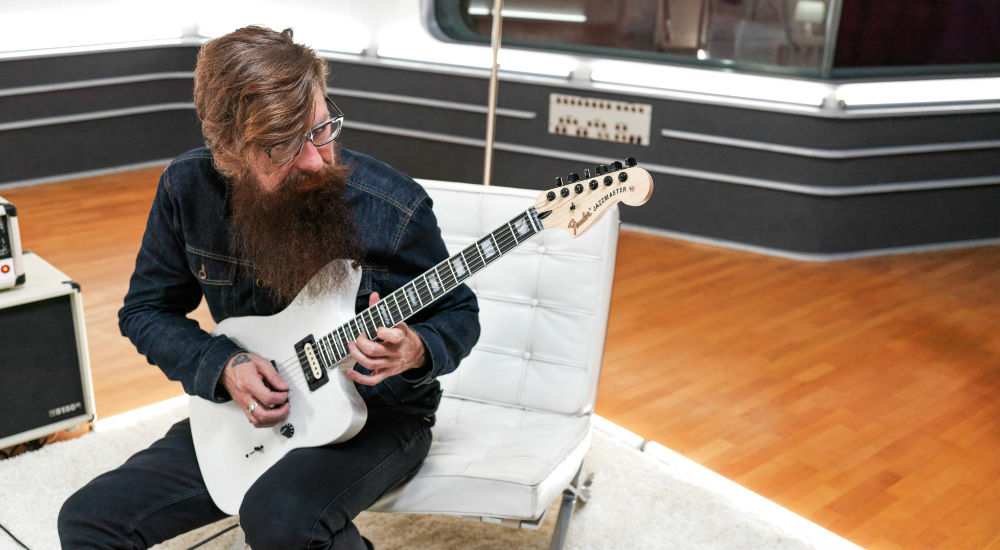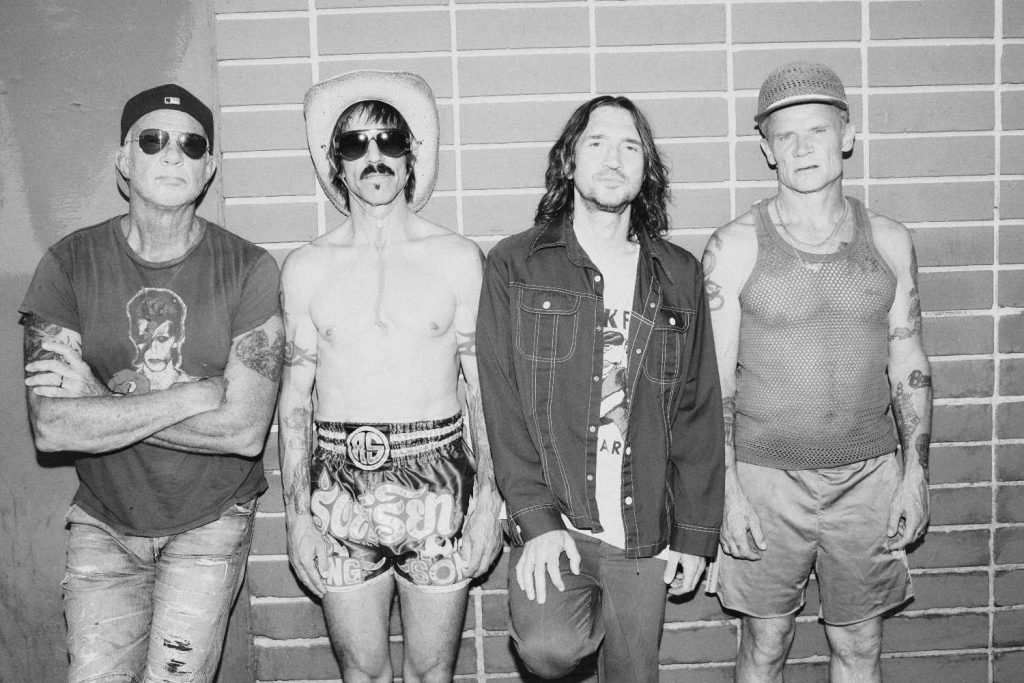This your third or fourth signature model with Fender. Why did you initially choose a Fender for the style of metal that you guys play?
“To me, Fender sort of invented the 25.5” scale, bolt-on neck guitar that everybody else makes a version of, like all the other Super Strats that are out there. I figured that if I’m going to be with a company, then I should probably be with the innovators of that kind of guitar, rather than people that are trying to reinvent the wheel.”
That’s not to say that there’s not other great guitars out there. When I was younger, I played Jacksons and Charvels, you know, all the guitars like that. I loved them to death. But you know, Fender’s been around for so long and they’re just such an iconic, inspirational sort of company. It just seemed like a no-brainer. Plus. I like the juxtaposition of playing the type of music that Slipknot do with a sort of a classic, iconic guitar that you wouldn’t normally associate with that type of music.”
Yeah, absolutely. That brings up another interesting point, because I suppose the Jazzmaster is often seen as the indie or grunge guitar. Was there anyone in particular that made you want to use a Jazzmaster?
“No, it was kind of random actually. Alex Perez over at Fender made one for me with my signature specs and kind of surprised me with it, and I was a little bit reluctant to use it for a while – I think I just had it sitting around for a month or so. I was getting ready to do rehearsals and pre-production for the Audio Secrecy record when I was in Stone Sour, and for whatever reason I just grabbed that guitar and used it during those rehearsals, and it was like a light switch turned on. It clicked in my head that it was just so well balanced and so comfortable. I kind of immediately fell in love with it and I was like ‘Why did I never try one of these before? Why did I let this thing sit around for so long before I actually gave it a chance?’
“From there, it kind of started a love affair with that body style and shape. It’s just so well balanced in the way it hangs and the way it sits, the fret access, just everything about it.”
Do you own any regular or unmodified Jazzmasters or Jaguars?
“Yeah, I have a regular American Professional one, and I also have a 1966 Jazzmaster as well, which I bought as a collector guitar. It’s nice. It’s like a Candy Apple Red with the binding and the matching headstock, like a real legit ’66 Jazzmaster.
“Fender also put out a few models recently that are dual humbucker stripped-down versions. I bought them from their website. I’ve got like four or five, just standard model ones. No Jaguars though. They’re a little bit too small. I think they have a smaller scale radius fretboard, I think they’re 24” or something aren’t they?”
That’s also something that’s always intrigued me about your signature models. You’re like 6’6” and play in some pretty heavy drop tunings – you kind of make a Jazzmaster look like a bit of a toy. Is there any reason why you stuck with the regular scale for all your signatures when you could have opted for something else?
“I didn’t want to change that up. I like to be classic. I don’t have the full body contours on it: it has elbow cut out and the belly cut, but my signature models don’t have the contoured body like the normal models do. They’re a little bit thicker they have a little bit more mass than the standard models. But I wanted to keep most of that stuff kind of the same. I mean like I’m 6’6”, but that doesn’t mean everybody that wants to buy one is going to be 6’6”, so it doesn’t really make a whole lot of sense, you know?”
That’s a good point. Can you walk us through the main differences between your new signature Jazzmaster and the one that preceded it? Were there any major changes or personal requests this time around?
“Yeah, the biggest change would probably be the neck, other than the colour. A lot of people were asking Fender about the white finish, so I figured if we’re going to put a white one out, then let’s mess around with the neck, let’s go a bit more traditional, let’s do a real Jazzmaster headstock, let’s do the binding, the big block inlays, kind of similar to the ’66 I have.
“But it’s also a tip of the hat to the original one. It’s still stripped down with all my specs, made to be abused and you know, kind of be a workhorse. You don’t really need all those switches. I don’t use that stuff. I don’t need a tone knob, and I’m not a jazz player. Clean or dirty, a neck and bridge pickup is all I need. To me, it’s a minimalistic, less-is-more kind of thing.
“It’s also got a 12” fretboard radius, which is different than the previous one, which had a compound radius. The actual neck shape of this one is a lot thinner. It almost feels more like a Jackson in some ways, it’s definitely more in that shredder world of neck shapes. It’s definitely slimmer than the Modern C profile that’s out there.”
This new Jazzmaster is also loaded with your new EMG Signature Daemonum pickups. What do they add to the vibe of the new model?
“The EMGs add a lot. They’re definitely not as compressed as the 81/60 combo that I was using. They’re still active, but they’re Retro Active pickups, so you get the tonal qualities of a passive pickup but they’re a little bit more dynamic. I spent a lot of time in the studio switching all the prototype pickups around and comparing them to the 81/60, recording them by themselves, recording them in the track, in various guitars. The ones that we ended up using are the ones that I ended up using on We Are Not Your Kind.
“Maybe to the ear you can’t necessarily hear it, but they have a wider frequency band. They’re definitely thicker and fuller. Even though they have less output, they’re a little less gain-y, because I use so much preamp gain with the my amps that I use that I really don’t all that compression and gain from the pickup. It’s almost overkill. So I toned these down a bit and went for more of a traditional tone.”
Did you go through several different prototypes with this signature guitar when you were recording the last Slipknot record? Was it like a testing phase for this guitar?
“I was lucky enough that we got to do it while we were sort of… Not really in the pre-production phase, but before we started trying to really lay him down serious tracks. So in the demo days, I was able to kind of really like shoot them out. I think we only did four different variations of the prototype before we landed on the ones that we landed on, which is relatively low in comparison to what I was told James Hetfield did with his first signature model. I think he went through 25 or 30 different prototypes before he picked out of his prototypes. I didn’t really want to overthink it.”
Between your signature Jazzmaster, Stratocaster and Telecaster, how do you use each guitar differently when playing with bands? Do they serve for different purposes, or different tunings?
“I was more when I was in Stone Sour, but now, it’s basically just on feeling and a style. The Tele obviously is an iconic body style, and every guitar I owned before then was a Strat shape, so I kind of also talked Fender into doing the Strat and they were gracious enough to let me have a signature model. Then when Alex sent me that Jazzmaster, I was playing it so much that they were getting people asking them like, ‘Is there ever going to be a Jim Root Jazzmaster?’, and that kind of led into that happening. So I guess I got kind of lucky, but at the same time, I don’t want to put too many models out there and oversaturate it and make people have to decide what they want to get, you know? Maybe at some point we’ll refine it down to just a couple.”
Yeah, for sure.
“One of the things I’m bummed about is that I can’t find a white Jim Root Strat anymore. They stopped making the white one! I love that white. If they ever gave me another model to do, I’d probably do another white Strat, but with an ebony fretboard and binding on the neck, similar to the Jazzmaster that we just put out.”
That’d be really sick – almost like an Aerodyne or something. Is that something you’d consider?
“Yeah, that’d be really cool to do an Aerodyne. Maybe even a Meteroa or something would be cool!”
That’d be so cool. Back in the day when I was going into guitar shops a lot, I always noticed that the Squier run of Jim Root Telecasters really, really popular – not just because it was good, but because it was also so affordable, and it went on to end up in the hands of players in bands from very different backgrounds. How important is it to you to work with Fender to get all the prices right so they can actually end up in the hands of players who need guitars like these?
“That’s really important to me. And it’s a really hard thing to do, because you know, you want to spec it out so that it’s playable and it’s good quality. But by the time you’re done spec’ing it out, you end up with a super-expensive guitar and it’s like, man, nobody’s going to be able to afford this. When we first did my original Tele, the way I had it spec’d it out, it was so expensive. Man honestly, I want to try to keep this thing around a thousand dollars or less, if we can. That’s the reason why we made them in Mexico, and that’s similar to what’s happening with the new Jazzmasters. They’re going to be Mexican-made just to try to keep those costs down so that people can afford it.
“It’s a really tough balance, but it’s also something that’s really important to me. I know the Squiers are really good, but Fender haven’t really talked to me about doing a Squier in any of the other models that I have. I think they have a different corporate structure. Squier is definitely a part of fender, but it’s like a separate division. And so, you know, I think Fender wants to keep things Fender and Squier wants to keep things Squier, similar to Charvel and Jackson. If I had it my way, I’d try to do a Squier version and all of my guitars, but I just don’t think that would jive with the way their corporate structure works at the moment.
“For me, it’s definitely an important thing. It’s just hard once you get to a point where you’re like ‘I want this fretboard radius, I want these frets, I want binding, block inlays, locking tuners, my EMGs and then a hardcase’ and then all of a sudden, you’re looking at a pretty expensive guitar. And then we’ve got to figure out a way to make this more affordable somehow without sacrificing what it is and what I really play. It’s important to me to be able to go to any guitar shop and buy any one of these guitars off the wall and just set it up the way I like it and play them all live.”
Head to Fender’s Australian website to check out the new Jim Root Jazzmaster today.











